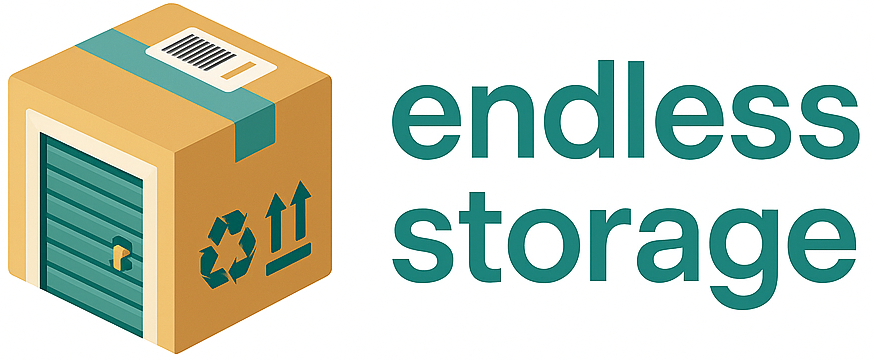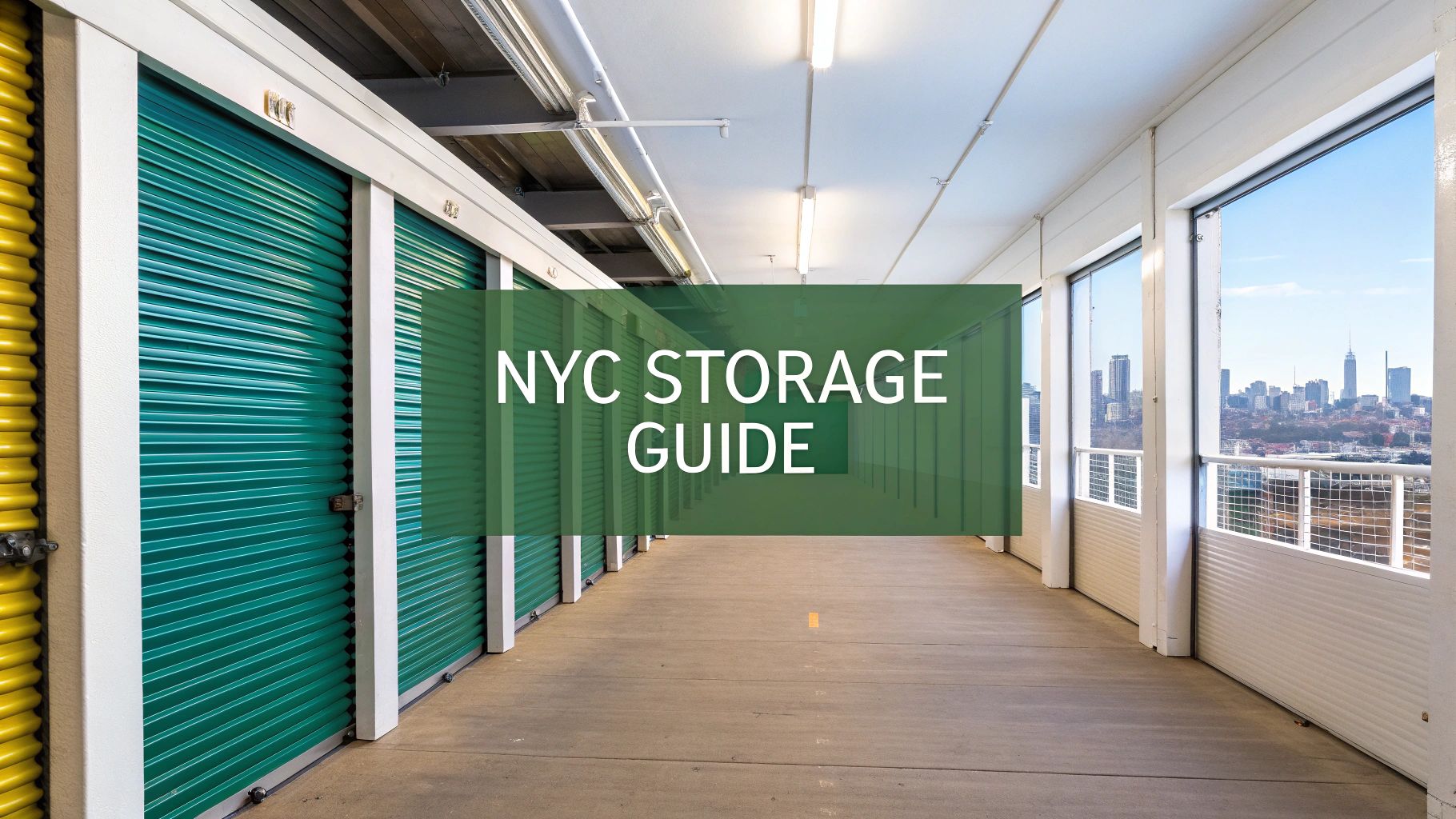Trying to find reliable self storage in NYC isn't like looking for a unit anywhere else in the country. Let's be real: space is the ultimate luxury here. Finding a spot for your stuff is less about stumbling upon an empty garage and more about a strategic mission—juggling cost, convenience, and pure logistics in one of the densest cities on Earth.
Why Finding Storage in NYC Is So Different
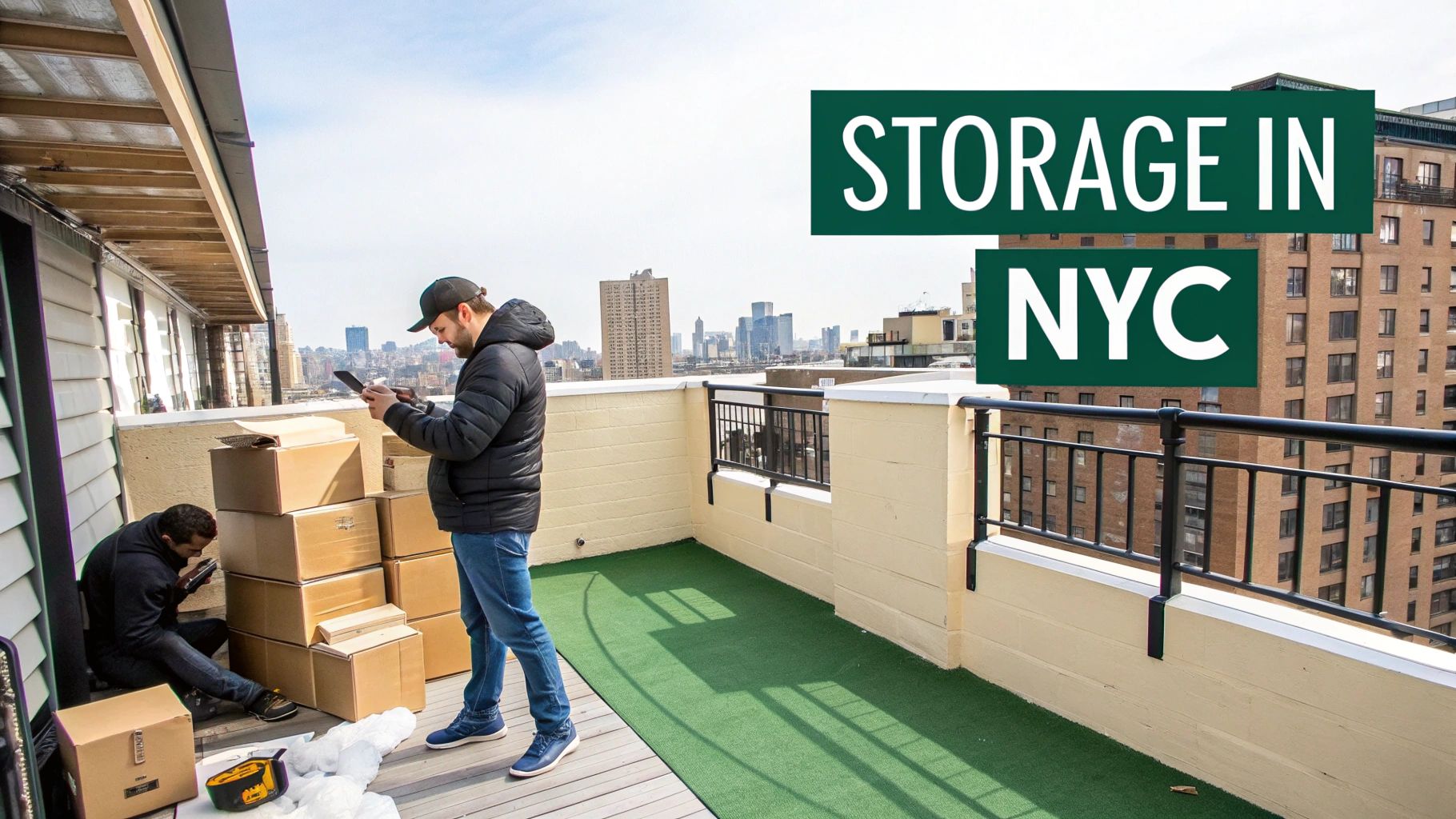
Whether you’re in a cozy Brooklyn brownstone or a slick Manhattan studio, you know the deal. Every single square foot matters. That makes off-site storage less of a "nice-to-have" and more of an absolute necessity for decluttering, swapping out seasonal gear, or just surviving a move without losing your mind.
But the city's density throws a wrench in the works. As of 2025, New York State has only about 2.53 square feet of storage per person. That’s less than half the national average of 5.4 square feet. This scarcity is a huge driver of both price and availability, which is why the hunt for a good unit can feel like a competitive sport. For a deeper dive into these numbers, selfstorage.com has some great market insights.
Traditional Units vs. Modern Solutions
Forget the classic image of pulling your car right up to a roll-up door. That's a rare sight in the five boroughs. Most NYC facilities are towering multi-story buildings, meaning your storage journey will probably involve elevators, long hallways, and a whole lot of schlepping. It's a logistical puzzle you have to solve yourself.
This very problem gave rise to a whole new way of doing things: full-service, or "by-the-box," storage. It’s a model built from the ground up for city dwellers who don't own a car or simply don't have the time to haul everything across town.
Full-service storage flips the script entirely. It tackles the biggest headaches of traditional storage—transportation and physical labor. Instead of you trekking to your unit, the storage solution comes right to your front door.
So, you're essentially looking at two very different paths for your storage needs. Seeing them side-by-side really helps clarify which one is right for you.
NYC Storage Options at a Glance
Before you decide, it’s worth comparing the two main approaches head-to-head. Here’s a quick breakdown of what you can expect from each.
Ultimately, your choice boils down to what you're storing and how much heavy lifting—literally and figuratively—you're willing to do.
Choosing the Right Size Storage Unit
Figuring out how much space you actually need is one of the biggest headaches when renting self storage in NYC. Paying for a unit that’s half-empty is like flushing money down the drain—especially in this city. On the flip side, trying to Tetris your entire life into a space that’s too small is a surefire way to damage your stuff and cause a massive headache.
The trick is to think about the space in terms you already know. For example, a 5x5 unit, which gives you 25 square feet, is basically the size of a small walk-in closet. It's the perfect spot for seasonal gear, a couple dozen boxes, or everything from a college dorm room.
Stepping up to a 10x10 unit gets you 100 square feet of space, which is a much bigger deal. Picture about half of a standard one-car garage. This size can comfortably handle the furniture from a one-bedroom apartment—we’re talking a couch, queen-sized bed, dresser, and a bunch of boxes. It’s a go-to choice for people between moves or tackling a home renovation.
Pro Tip: Before you sign anything, do a quick inventory of your biggest items—sofa, mattress, dining table. Their measurements are going to be the main driver for the smallest unit you can get away with.
Common Storage Unit Sizes and What They Hold
To make it even simpler, let's break down what you can realistically cram into the most common unit sizes you'll come across.
- 5x5 Unit (25 sq. ft.): Your extra closet. Great for a few small pieces of furniture, personal files, holiday decorations, or around 20-30 medium boxes.
- 5x10 Unit (50 sq. ft.): This can hold the contents of a typical studio apartment. Think a sofa, chair, dresser, mattress set, and still have room for more boxes.
- 10x10 Unit (100 sq. ft.): Fits the furnishings of a one-bedroom apartment. You can get major appliances, bulky furniture, and tons of boxes in here, with enough space left to create an aisle so you can get to things.
- 10x20 Unit (200 sq. ft.): Now we're talking. This is the size of a standard one-car garage and can hold everything from a multi-bedroom house, including the big appliances, furniture, and even patio sets.
For an even more detailed look, our complete storage unit size guide can help you perfectly match your stuff to the right space.
Why Climate Control Is Non-Negotiable for Certain Items
Beyond just the size, you've got another major choice to make: a standard unit versus a climate-controlled one. A standard unit is essentially a garage—it keeps the rain out, but it’s still at the mercy of NYC’s wild temperature and humidity swings. With our scorching summers and freezing winters, that can be a death sentence for your sensitive belongings.
Climate-controlled units, on the other hand, maintain a stable temperature and humidity level all year long. This is absolutely critical for protecting your valuables from warping, cracking, molding, or rusting. If you're storing any of the items below, you should treat climate control as a mandatory investment, not an optional upgrade:
- Wooden or leather furniture
- Electronics and media (laptops, TVs, vinyl records)
- Artwork, photographs, and important documents
- Musical instruments
Honestly, the extra cost for climate control is tiny compared to what it would cost to replace your most treasured items. It’s the peace of mind knowing your things will come out looking exactly the same as they did when you put them in.
Understanding the Real Cost of NYC Storage
Let’s be honest: the price you see advertised for self storage in NYC is rarely what you end up paying. Think of that monthly rate as just the starting point. To find a good deal, you first have to understand what drives that base price up or down. Location isn’t just a factor; it’s the factor. A 5x10 unit in a prime Manhattan neighborhood can easily cost double what the same size unit goes for in the Bronx or Staten Island.
This price gap is just a reflection of the city's wild real estate market. Facilities pay a premium for land in dense, accessible areas, and guess who that cost gets passed on to? You. But even inside the same building, prices vary. Ground-floor units are super convenient, so they often come with a higher price tag. If you don't mind a trip in the elevator, units on upper floors can save you a few bucks.
Breaking Down the Boroughs
To set a realistic budget, you need to think borough by borough. Each one is its own little ecosystem when it comes to storage, with prices shaped by demand, subway access, and how many facilities are competing for your business.
- Manhattan: No surprise here—this is where you'll find the highest prices, especially anywhere south of 96th Street. You're paying for unparalleled convenience, and you'll pay a lot for it.
- Brooklyn: Prices are all over the map. Trendy spots like Williamsburg or Dumbo can give Manhattan a run for its money, but if you look further out in neighborhoods like Canarsie or East New York, you'll find much more affordable options.
- Queens & The Bronx: Generally, these boroughs offer the sweet spot between cost and accessibility. You can find significantly lower rates here, making them a smart move if you don’t need to get to your stuff every single day.
To give you a better sense of what you'll be looking at, the infographic below shows the most common unit sizes people rent.
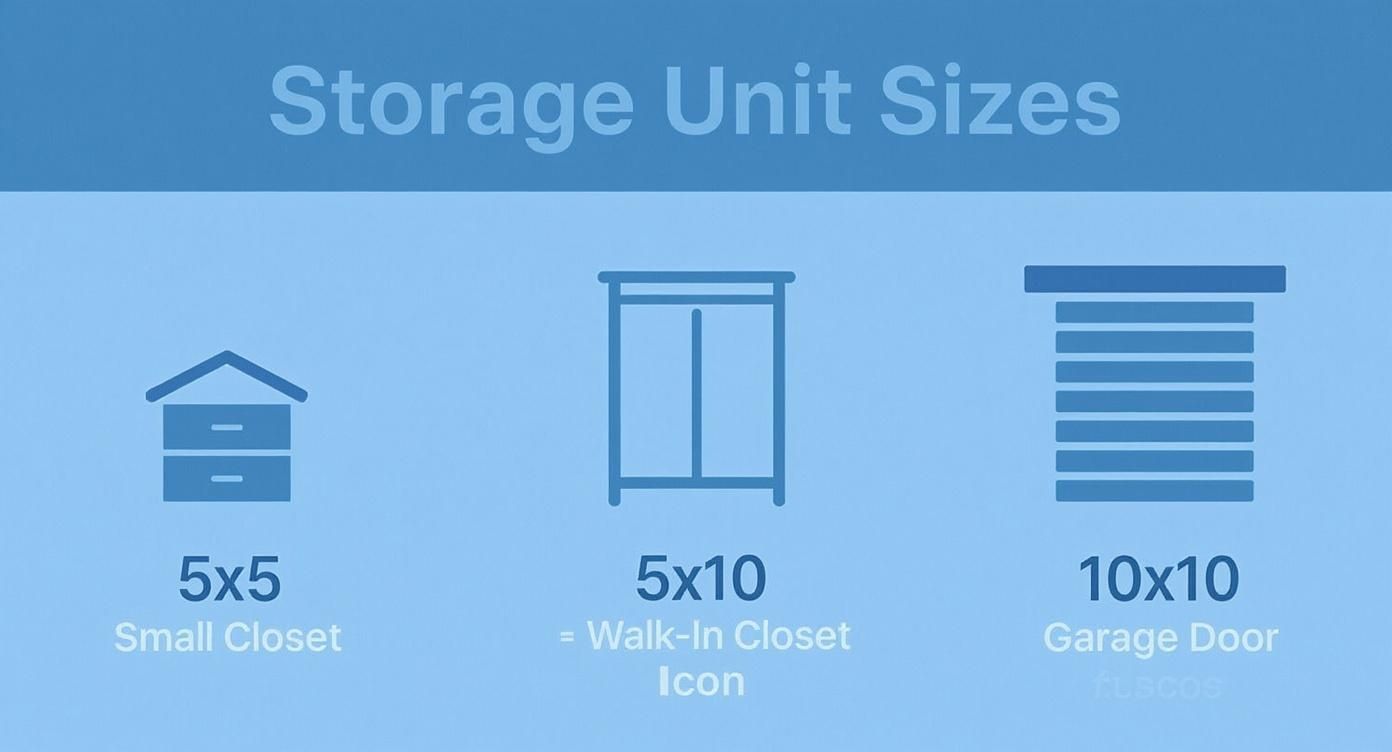
This helps put the popular 5x5, 5x10, and 10x10 options into perspective—they really are the bread and butter of NYC storage.
This dynamic of high demand and tight space isn't letting up anytime soon. While new self-storage facilities are popping up all over the country, dense urban markets are a different beast. In 2025, New York was actually projected to see a 13% decrease in new self-storage space, which is the complete opposite of the national trend. This supply crunch directly affects your wallet. You can see how these market dynamics shape storage costs in RentCafe's detailed report.
Beware of Hidden Fees
Beyond the monthly rent, a handful of extra charges can sneak up on you and inflate your total bill. Knowing about these from the get-go will save you from sticker shock down the road.
The real cost of storage is the monthly rate plus all the extras. Always ask for a full breakdown of mandatory fees before signing a contract to get a true picture of your total investment.
Here are the common add-ons to watch for:
- Administrative Fee: This is a one-time charge for setting up your account, usually around $20-$30.
- Mandatory Insurance: Most places require you to have insurance. If your homeowner's or renter's policy doesn't cover off-site storage, you'll have to buy their policy, which can tack on another $10-$25 a month.
- Lock Fee: You can't just use any old padlock. You'll need to buy their specific high-security lock, which will set you back about $15-$25.
These little fees might not seem like much on their own, but they add up fast. For a more detailed breakdown, check out our guide on how much storage costs, where we dive even deeper into these factors.
What to Look For in a Secure Facility

When you put your belongings in a storage unit, you're not just renting four walls and a door—you're buying peace of mind. Knowing your stuff is safe and sound is absolutely non-negotiable, and the right security features make all the difference. Think of it like layers of an onion; each feature adds another level of protection.
The absolute foundation of a secure facility starts with controlled access. At a bare minimum, look for a perimeter fence and a computerized gate that requires a unique code to get in. This is the first line of defense, making sure only paying customers and staff can even set foot on the property.
Advanced Security Measures
Beyond the front gate, modern facilities have a lot more to offer. 24/7 video surveillance has become the industry standard, with cameras watching over key areas like entry points, hallways, and loading docks. This isn't just about deterring would-be thieves; it also provides a crucial record if an incident ever occurs.
Some places take security a step further with individual unit alarms. With these systems, an alert goes off if someone opens your specific unit door without first punching in your access code. It’s like having a personal alarm for your belongings. To see how all these features come together, exploring a top-tier self-storage facility can give you a clearer picture of what to expect.
Peace of mind isn't just about preventing theft. It's also about feeling safe when you visit your unit, day or night. A well-lit facility with an on-site manager during business hours adds a human touch to security that cameras just can't replicate.
Access Hours and Convenience
Security and convenience go hand-in-hand. What good is a secure unit if you can't get to your things when you need them? Many facilities operate on standard business hours, but if your schedule is unpredictable, you’ll probably want a place that offers 24/7 access.
This feature is a game-changer for anyone working late shifts, moving at odd hours, or just needing to grab something on a whim. Always, always confirm the access hours before signing a lease to make sure they actually work for your life.
Protecting Your Valuables with Insurance
Finally, even the most buttoned-up facility can't guard against every possibility—fires, floods, you name it. That’s where insurance comes in. Most reputable places offering self storage in NYC will require you to have coverage for your stored items.
Don't just assume your existing homeowner's or renter's policy has you covered. Many policies have surprisingly low limits for items stored off-site. You generally have two options:
- Use Your Existing Policy: Give your insurance agent a call to see if your current plan offers enough coverage. You might need to add a simple rider to get the protection you need.
- Buy from the Facility: This is often the path of least resistance. Most storage companies offer their own insurance plans, which are designed specifically for stored goods and can be added to your monthly bill for a reasonable fee.
Solving Your NYC Moving and Logistics Problems
Renting self storage in NYC is one thing, but getting your stuff to the facility is a whole different beast. In a city of one-way streets, alternate-side parking nightmares, and buildings with move-in rules stricter than a nightclub bouncer, logistics can turn into your biggest headache. A smooth move-in day isn't about luck; it's about having a solid game plan.
First up, you have to master the temporary park. You can't just throw a moving truck in park wherever you feel like it. Before the big day, do a little recon around the storage facility. Look for commercial loading zones or check out nearby parking garages. Let's be honest, successfully navigating a move often comes down to challenges like finding parking in New York City. A little planning goes a long way.
Your Pre-Move Logistics Checklist
Don't wait until you’re double-parked with the meter running and movers staring at you to figure things out. Give the facility manager a call beforehand and get the answers to these crucial questions.
- Loading Dock Access: Is there a loading dock? If there is, what are the hours, and do you need to book a time slot?
- Elevator Reservations: So many multi-story facilities in NYC require you to reserve the freight elevator. Forgetting this simple step can lead to some seriously long and expensive delays.
- Equipment Availability: Ask if they have dollies and handcarts you can use for free. Knowing this ahead of time could save you a rental fee and a whole lot of back pain.
- Vehicle Restrictions: Are there any size or height limits for vehicles trying to get into the loading area? This is a big one, especially if you’re renting a large truck.
Think of your move-in like a doctor's appointment. By coordinating with the facility first, you can turn what could be a chaotic mess into a smooth, streamlined process. It'll save you time, money, and a massive amount of stress.
Of course, the best way to solve all these logistical problems is to just avoid them completely. For a lot of New Yorkers, the hassle of renting a truck, sitting in traffic, and then lugging boxes is just not worth it. This is where some of the more modern storage alternatives really shine.
Services that handle all the transportation for you cut out the most stressful parts of the entire process. If you want to learn more, our guide on self-storage delivery services breaks down how you can get your items into storage without ever renting a U-Haul or circling the block for parking. When you tackle these real-world obstacles head-on, you can turn a dreaded move-in day into something surprisingly efficient and pain-free.
Packing and Organizing Your Unit Like a Pro
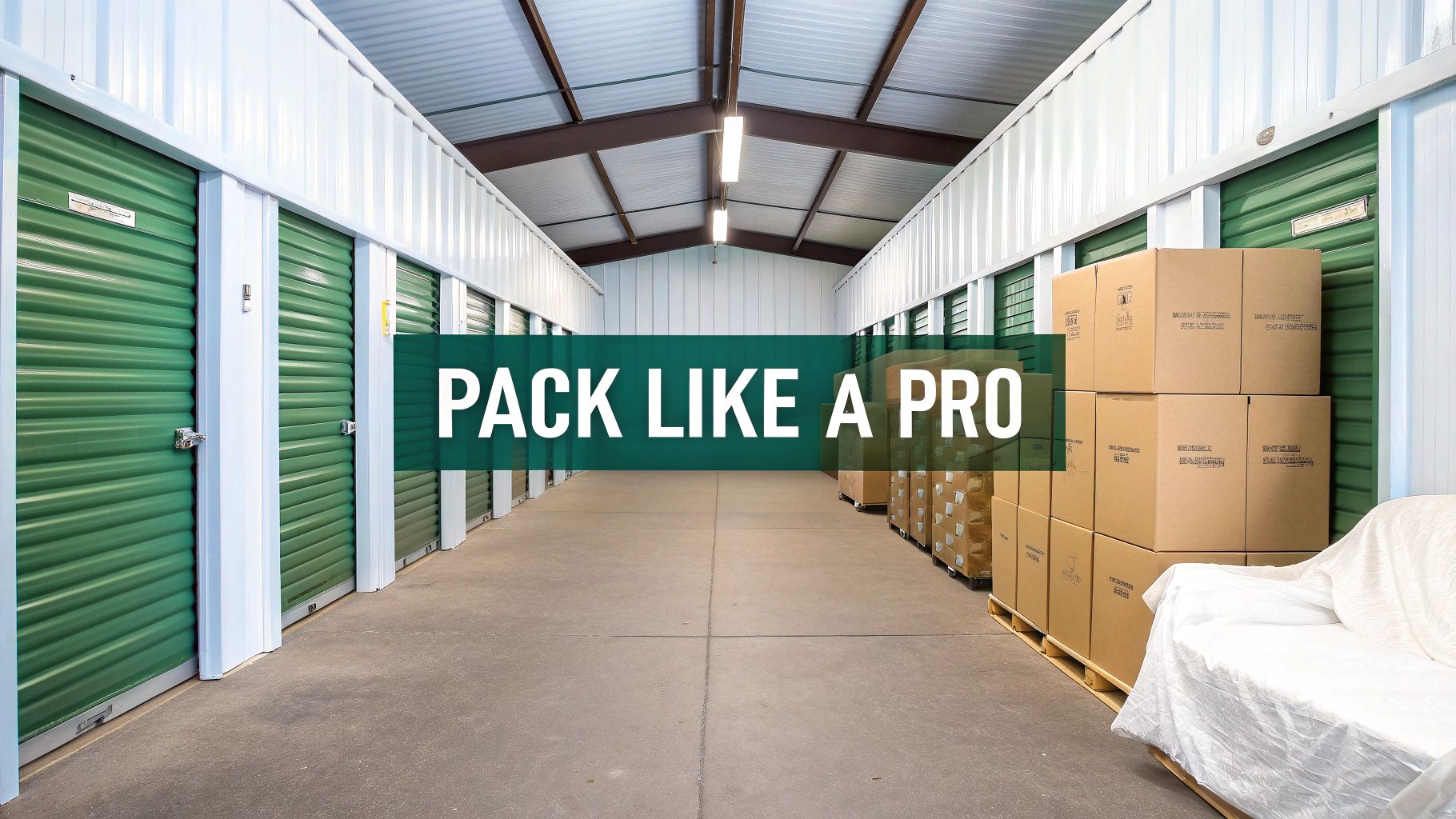
We’ve all seen it: the storage unit that looks more like a junk drawer someone just tipped over. This is a rookie mistake, and it’s a recipe for frustration down the line. A well-organized unit isn't just about looking neat; it’s about making every square foot count, keeping your stuff safe, and being able to grab what you need without a full-blown excavation. The goal is simple: make the unit work for you, not against you.
It all starts with the boxes. I know it’s tempting to grab whatever free boxes you can find, but trust me on this—using uniform, sturdy, same-sized boxes is a complete game-changer. They stack like perfect building blocks, creating stable walls that won’t buckle or collapse. It’s a small step that prevents crushed boxes and heartbreak later.
Smart Stacking and Accessibility
Once you’re packed and labeled, it’s time to think like a warehouse manager. The number one rule? Always leave a central aisle. Even a skinny walkway is enough to give you access to the back of the unit, saving you from having to unpack the whole thing just to find one box. It’s the difference between a solid, immovable block and a functional miniature storeroom.
Here are a few more pro tips for getting your unit set up right:
- Heavy Goes Low: Always, always put your heaviest boxes and bulky items on the floor. This creates a solid foundation. Lighter, more delicate things should go on top.
- Break It Down: Taking apart bed frames, tables, and bookshelves saves a shocking amount of space. Just be sure to put all the screws and small hardware in a labeled bag and tape it securely to the biggest piece.
- Cover Up: Use old blankets, sheets, or furniture covers to protect wood and upholstery from dust and scratches, especially while you're looking for the right self storage in NYC.
Here's a trick that has saved me countless headaches: sketch a simple map of your unit's layout and tape it just inside the door. Knowing your vintage record collection is in the back-left corner is a whole lot better than guessing.
Keep Track of Your Inventory
Finally, an inventory list is non-negotiable. It doesn’t have to be fancy; a simple spreadsheet or a note on your phone that lists what’s in each numbered box is perfect. This turns a pile of boxes into a searchable database, so you know exactly where to find your winter coats or holiday decorations.
And remember to place the items you know you'll need most often right at the very front. Future you will be grateful.
Got Questions About NYC Storage? We’ve Got Answers.
Even after you've locked down the perfect facility and unit, a few last-minute questions can pop up when you’re dealing with self-storage in NYC. Think of this as your go-to guide for clearing up any final uncertainties, so you can rent with total confidence.
One of the biggest things people ask about is the move-out process. It’s not as simple as just clearing out your stuff. Most places require a written heads-up, usually 10 to 30 days before you plan to vacate. Dig out that lease agreement and check the fine print—it’ll save you from getting billed for an extra month you weren't planning on using.
What Can I Actually Store?
While you can pack away most of your household or business gear, there are some hard-and-fast rules about what’s off-limits. These aren’t just suggestions; they’re in place for safety, legal, and insurance reasons that protect you, your stuff, and the facility.
As a rule of thumb, you can't store any of the following:
- Perishable Goods: Anything that can spoil or attract pests is a no-go. No food, period.
- Hazardous Materials: This covers flammable, corrosive, or explosive items. Think gasoline, paint, propane tanks, and fireworks—all strictly forbidden.
- Living Things: This one should be obvious, but just in case: no plants and definitely no animals.
- Illegal Items: Stolen goods, unregistered firearms, and any illicit substances are not allowed.
It's simple: if it’s dangerous, alive, or could rot, it doesn’t belong in a storage unit. If you're ever on the fence about an item, just ask the facility manager before you bother packing it.
Market Prices and Payments Explained
New Yorkers always want to know: are storage prices negotiable? Not usually. The self-storage market is surprisingly dynamic, heavily influenced by real estate trends and investor money. In the first half of 2025 alone, transaction volume for storage facilities across the country hit about $2.85 billion.
Even though valuations peaked back in early 2023 and have since cooled off, NYC's insane demand and tight supply keep it a premium market. You can actually dive deeper into these self-storage market trends to see what’s driving your monthly rent.
Finally, let's talk about what happens if you pay late. Life gets messy, and a due date might slip by. Most facilities give you a grace period of a few days. After that, you'll get hit with a late fee, and your access code will probably be deactivated until you're paid up. If you fall seriously behind, the facility can put your unit in lien status, which is the first step toward eventually auctioning off its contents. It’s a road you don’t want to go down.
Ready to ditch the hassle of traditional self-storage for good? Endless Storage is built for modern NYC life. We handle the pickup, storage, and return of your items whenever you need them, so you can say goodbye to visiting a storage unit forever. Get started with Endless Storage today!
Frequently Asked Questions
Unveiling the Secrets to Effortless Storage
Endless Storage is available nationwide. You pick a plan, tell us where to pickup, and we'll send a UPS van to collect, whichever state you're in.
Your shipping label will be sent to your email within a few minutes, if not instantaneously. It can also be accessed through your customer profile.
Your box will be shipped to one of our climate controlled self storage facilities in our closest self storage facility. Our manager will accept your package, notify you that your box has been received, and securely stored. Only our managers will have access to Endless Storage boxes.
Email us at admin@endless-storage.com click to live chat with us, or send us a message below.
Never! We're committed to transparent pricing with no surprises. You'll lock in your rate with no hidden fees and no long-term contracts.
Fast access guaranteed! Your boxes will arrive at your doorstep within 48 hours of requesting them back. Need to check on delivery? We provide tracking information for complete peace of mind.
Totally flexible! Store month-to-month with no long-term commitment and cancel anytime.
Everything's online! Use your account dashboard to:
• Set up automatic monthly payments
• Request box returns
• Update your address
• Order additional boxes
• Track shipments
Your boxes are insured up to $100 each. Our customer service team will help you file any necessary claims and resolve issues quickly.
Don't worry – we'll email you right away if there's a payment issue. Your items stay safe, though you may have temporary service interruption or late fees until payment is resolved.
When you request our free storage kits, you'll have 30 days to send in your boxes to activate your 3 months of free storage. Think of it like starting a gym membership – your activation window begins when you receive your kits, and your full free trial begins once you send in your first box. During your free months, you'll experience our complete storage service at no cost.
Your 30-day activation window begins when you receive your storage kits. We'll send you an email confirmation when your kits are delivered, marking the start of your activation period.
If you haven't sent any boxes for storage within your 30-day activation window, your free trial will expire and we'll begin charging the regular monthly rate of $9.99 per box. This helps ensure our storage kits go to customers who are ready to use our service.
A box costs $9.99 per month to store (plus sales tax). This price includes free shipping for standard boxes under 50 lbs. and smaller than 16"x16"x16"
Log into your Endless Storage account, locate the box you would like returned, and simply click Return My Box.
Yes, each box stored with us is insured for up to $100 throughout transit as well as the duration of storage within our facilities.
Your box will be at your doorstep within 48 hours of you requesting it back.
Store 10+ boxes? We'll pick them up for free! After your purchase, we'll contact you to schedule a convenient pickup time and arrange UPS collection.
We trust UPS with all shipments, and every box includes $100 insurance coverage. You'll receive tracking information to monitor your items' journey.
Yes! Visit any of our locations by appointment. Just bring a photo ID matching your customer profile.
For everyone's safety, we can't store hazardous materials, firearms, or perishables. All items must fit within our standard boxes.
It's easy! Order your storage kit online, and we'll ship it to you within 1-2 business days. Your shipping labels will be emailed instantly and available in your account.
We're here to help! Email us at admin@endless-storage.com, use our live chat, or send us a message through your account.
To cancel your storage service with Endless Storage, please email your cancellation request to admin@endless-storage.com. Our team will process your request within 2 business days and confirm your cancellation via email.
We understand packing takes time. However, to maintain your free trial benefits, you'll need to send at least one box within the 30-day activation window. If you need more time, you can always start with one box to activate your trial and send the rest later. You can always reach out to admin@endless-storage.com if you have any issues or concerns.
When you request our free storage kits, you're starting a 30-day window to begin using our storage service.
To avoid any charges, simply send at least one box for storage within 30 days to activate your 3-month free trial. If you decide not to use our service and don't send any boxes within the 30-day window, a one-time $50 fee will apply to cover the costs of materials and shipping. This helps ensure our storage kits go to customers who are ready to use our service.
Think of it like reserving a hotel room – we're setting aside space and sending specialized packing materials for your use. The fee only applies if you request materials but don't begin storage, similar to a hotel's no-show charge.
